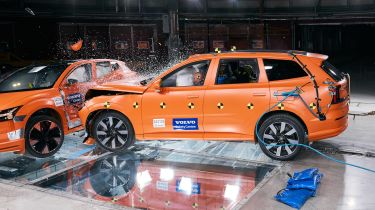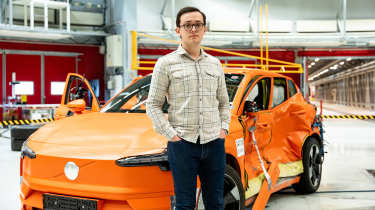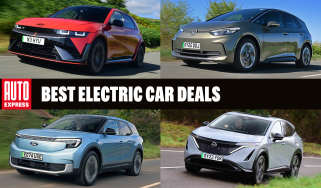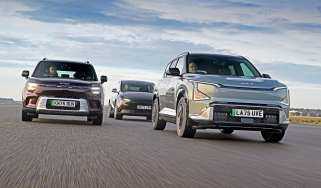Car safety: Volvo shifts focus to crash avoidance
We witness Swedish brand crash test its newest electric vehicles and find out what the next step is for automotive safety
According to Newton’s third law of motion, if two objects collide, the forces they impart on each other are of equal magnitude to what was propelling them in the first place. In layman’s terms, this means that when a car stops moving – in a crash, for example – there’s quite a bit of excess energy that needs to be redistributed somewhere – especially when it comes to larger vehicles.
It’s no wonder then that so many people are concerned about how our streets are rapidly being populated by two-tonne-plus electric SUVs, with some even touching three tonnes. Only a few decades ago such heft was reserved for the most expensive of luxury cars or commercial vehicles.
Now, even Volvo’s entry-level electric SUV, the EX30, weighs in at 1,830–1,943kg, depending on specification. While there are some outliers, such as the 1,300kg Renault 5 that is considered a bit of a lightweight by EV standards, it’s safe to say that even the smallest EV is comparable in weight terms to a much larger petrol family car, with the biggest EVs approaching the limit for a standard B1 driving licence.
Volvo invited us to its state-of-the-art facility, just outside Gothenburg, Sweden, to witness a crash test between the EX30, and the 2.8-tonne behemoth that is its new range-topping seven-seat EX90.
The Volvo Safety Centre is the jewel in the Swedish maker’s crown and is based around two 100-metre-plus crash-test tracks, each able to propel a three-tonne car at speeds of more than 56mph. There’s a giant moose crash-test dummy, too, but the piece de resistance is the fact that the entire building can be rotated at the press of a button, enabling Volvo to configure a variety of scenarios.
For this test, the cars were positioned to mimic a crash at a junction; the EX30 acted as the car pulling out, travelling at 12mph, while the EX90 played the oncoming vehicle, crashing into the side of the EX30 at 31mph. In both cars were a variety of crash-test dummies, each representing a person of a different size and gender, and costing as much as 1million Euros each. That’s a reflection on the sheer number of complex sensors inside that are used to measure G-forces and potential trauma.
After some pre-flight checks, the lights dimmed and the countdown began. The crash was over rather quickly, accompanied by a “thump” as the cars collided.
We are taken to the crash site by Volvo’s Senior Safety Expert, Thomas Broberg, who explained that none of the occupants would have sustained severe injuries, which may seem surprising given the sheer size difference between the two vehicles.
Key to protecting passengers is the low beam mounted in the EX90’s bumper that, Broberg tells us, is “designed to engage the safety systems in smaller and lower cars”. The effect this had is clear, with the EX90’s front end absorbing most of the impact, meaning the occupants of both cars were protected.
Alongside innovations such as run-off road protection (seats that are designed to absorb bumps to avoid spine injuries) and curtain airbags, it’s evident that passenger protection is at an all-time high. But what about other road users that may find themselves in the path of a two-tonne EV?
Broberg explains that “the traffic environment is incompatible from the beginning”, which means the concept of heavy blocks of metal flying around at high speeds doesn’t seem any more or less dangerous, regardless of whether a car weighs one or three tonnes. This is an interesting perspective, but we’ll leave it up to you whether you agree or not.
Regardless, Volvo has decided to shift its focus more towards crash prevention than crash protection. “This is a kind of ‘Hubble telescope moment’ of automotive safety that we’re about to witness,” Broberg says. “We are pioneering crash-avoidance technology by focusing our efforts on the driver, and using behavioural science and shared customer data, to fully understand how the conditions for a crash develop.”
We sit down with Mikael Ljung Aust, a scientist who works in tandem with Volvo, researching the causes of crashes. He explains that in an hour of driving, the average driver spends roughly 12 minutes with their eyes off the road, either looking at passengers, or their car’s infotainment system. This lack of attentiveness is why he and Volvo firmly believe in the idea of integrating more and more technology in order to monitor road conditions.
“A computer can’t really be inattentive – unless you programme it to be,” Aust laughs. “On the other end of the scale, you have humans who are extremely good at perceiving when something’s a little bit off – for example, someone that looks as if they may walk into the road. Artificial Intelligence (AI) will certainly help, but it’s only as smart as you make it.”
There’s always a fine line between an active safety system being helpful, or just plain annoying to the point you turn it off. Aust admits: “The real challenge is both detecting when people really need help, but [also] when people do not need it.
“People are hardwired to be extremely good at filtering noise,” he adds. “We have to be right [at least] eight times out of 10 for someone to see something as useful.”
Broberg adds that there is “no reduction in passive safety while Volvo focuses on active safety”. The firm pledged in 2014 that there would be zero fatalities in its cars by 2020. Volvo has admitted it was unable to achieve that goal, even today. But it appears its multi-faceted approach may be a path to getting that little bit closer. “Will we get there? We don’t know,” Broberg says. “But we won’t ever stop trying.”
Click here for our list of the 10 best features for car safety...










